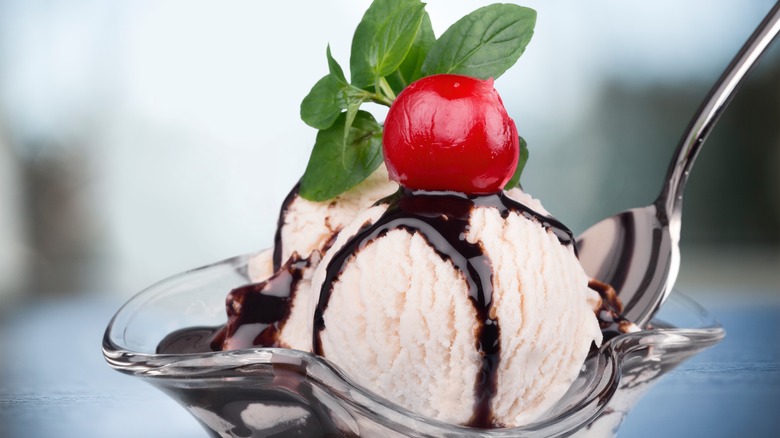This Historic Ice Cream Shop Gave Us The First Hot Fudge Sundae
Ice cream myths abound, some even involving the first president of the U.S., according to Smithsonian Magazine. The sweet treat has come a long way since landing on American shores in the 1700s, no longer requiring imported salt and river-cut ice stored by elites in private ice houses. We now get our ice cream on a whim-and-urge basis, with dozens of pickup options at everyday supermarkets. But when it comes to all-time favorite ice cream concoctions like the ice cream sundae, that's a whole different story. Especially the wildly popular hot fudge sundae.
The online Official Home of the Ice Cream Sundae — by noted ice cream author Michael Turback — claims that the first ice cream sundae came from his hometown of Ithaca, New York. Visual evidence of a "cherry sundae" advertisement in the Ithaca Daily Journal on April 5, 1892, pretty much establishes an official oldest-known record — though earlier claims to sundae-fame do exist (via Farmers' Almanac). But there's little argument to the origins of what many consider America's favorite version, the hot fudge sundae.
It's all about the fudge
In 1906, several years after ice cream sundaes premiered on the East Coast, a man named Clarence Clifton Brown opened an ice cream parlor in downtown Los Angeles. He became the now-infamous inventor of hot fudge sundaes, according to the Los Angeles Times. By1928, his son had moved C.C. Brown's ice cream shop to Hollywood Boulevard, where it became a hot-spot for celebrities. The likes of Judy Garland, Bob Hope, and Barbara Stanwyck reportedly indulged in sundaes after movie premieres at the nearby Chinese Theatre, per Historical Marker Database. A historical sign at 7007 Hollywood Boulevard still marks the iconic spot.
The thick secret-recipe fudge at C.C. Brown's famously remained the same for decades, even being made in original copper kettles delivered by covered wagons. Sadly, the iconic ice cream parlor served its final sundae in 1996, after 90 years in business (via Los Angeles Times). But its legacy lives on through devotees that still enjoy this deliciously sweet treat today.

